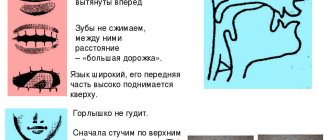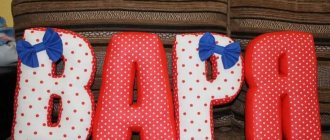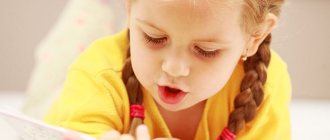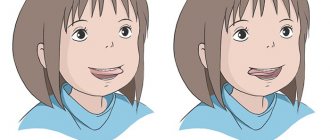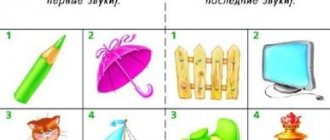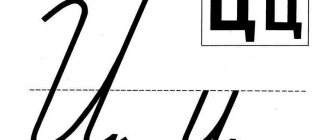Now you will learn about the letter and sound B.
B uratino, b ara b an,
B- tree, b- ulka and b- anan.
Who plays the trumpet ?
Our guest, b ukva " B "!
As you learned earlier, letters come in vowels and consonants. We became familiar with the vowel sound [a] and its letter, and you know that when we pronounce a vowel sound, the air comes out freely, without encountering any obstacles on the way. If the air meets obstacles, it means a consonant sound is pronounced.
In this lesson we will learn about the letter B and its sound, the first letter of the alphabet with a consonant sound.
When pronouncing the sound [b], the air encounters an obstacle on the way, we cannot sing such a sound, this sound is a consonant.
Let's pronounce this sound in words: b a b ochka, b fir-tree, b mustache.
We will hear a ringing voice. The sound [b] is sonorous. Let's determine whether the sound [b] is hard or soft.
Let's compare the words: bashnya , b white.
In one word the sound [b] is hard, in the second the sound [b´] is soft. The letter is the same, but the sounds are different. In this case, for the correct pronunciation of words with B , the helper letters that come after will help us. If followed by the letters E, Yu, E, I, I , then the consonant sound is soft. If followed by the letters O, A, U, Y , then the consonant sound is hard.
The letter B denotes a consonant, voiced sound, which can be either hard or soft.
The letter B in Russian behaves actively and can appear anywhere in a word. For example, a ballerina.
At the beginning of the word, a hard sound [b] is heard, since the letter B is followed by the letter A , which indicates the hardness of the consonant sound.
The word be gun. At the beginning of the word, a soft sound [b´] is heard, since the letter B is followed by the letter E , which indicates the softness of the consonant sound.
Let's remember the words in which the letter B is in the middle of the word. Guess the riddle:
We returned at a late hour.
Who greets us at the door?
Who wags his tail with happiness
And he dances on his hind legs...
(E. Grudanov)
Answer: so ba ka
In the middle of the word, a hard sound [b] is heard, since the letter B is followed by the letter A , which indicates the hardness of the consonant sound.
Let's look at words with a soft [b´] in the middle: ki bi tka.
In the middle of the word, a soft sound [b´] is heard, since the letter B is followed by the letter I , which indicates the softness of the consonant sound.
Let's look at words with the letter b at the end.
The word table b .
A word is written with the letter B at the end, but when you pronounce the word pillar, the sound [p] is heard. We'll soon find out why this happens. Let's name words in which the letter B occurs more than once: b o b er, b a b ochka, b u b lik, b u b e n, b a b ushka, b a o b a b.
Guess the riddle, the letter B :
Without worrying about the weather,
in a white ,
And on one of the warm days
May gives her earrings.
Answer: birch .
Let's count how many letters B , hard and soft sounds [b] are in the riddle. This riddle contains two letters B , one hard sound [b] and one soft sound [b´].
This letter has a funny belly and looks like a hippopotamus.
return to the page “Russian language 1st grade” >>>
If you liked it, share it with your friends:
Join us on Facebook !
Conversational Russian – Real Language Club
See also:
- Russian texts with audio
- Dialogues in Russian
- Video in Russian with subtitles
- Correct pronunciation exercises
- Russian tongue twisters in audio format
- Common phrases in Russian
- Russian slang expressions
- Jokes in Russian with translation into English
Preparation for Russian language exams:
- OGE in Russian language
- Unified State Examination in Russian
- Exams for migrants (Patent, temporary residence permit, residence permit, Russian Federation citizenship)
We recommend:
- The best Russian tutors
The most necessary from the theory:
- Grammar of Russian language
We suggest taking tests online:
- Russian proficiency test
- Russian vocabulary test
- Russian grammar tests
- What language should I learn?
Recommended articles and videos:
- How to successfully pass an interview in Russian
- TV is a means of learning a foreign language
- Interesting tests: find out your level of language proficiency
- Gymnastics for linguists: a complex for correct pronunciation
- 5 rules for successful language learning
- How to improve your knowledge of a foreign language: three tips and five rules
- How to improve your speaking fluency
- Video: “How to improve pronunciation and understanding
More articles >>>
Russian language with tutors online
Now you can learn the Russian language on your own, using the free resources of our educational website, as well as choose a suitable tutor from our partner and study at the TutorOnline school:
- Individual sessions
- Affordable prices
- Convenient payment methods
- Free introductory lesson
- Money Back Guaranteed
How to choose a Russian language tutor
Free trial lesson with a tutor
Article:
Preschool childhood is a short but important period of personality development.
During these years, the child acquires initial knowledge about the life around him, he begins to form a certain attitude towards people, towards work, develops skills and habits of correct behavior, and develops a character. The child’s speech develops gradually. The main goal of correctional work for violations of the pronunciation of sounds is the formation of skills and abilities to correctly reproduce sounds in the speech stream.
Automation of sound is the consolidation of the correct movements of the articulatory apparatus to pronounce a particular sound.
During the automation process, sound goes through several stages in succession and this sequence must not be violated under any circumstances.
Automation of sound in syllables (direct, reverse, with confluence
consonants);
2. Automation of sound in words (at the beginning of the word, middle, end);
3. Automation of sound in sentences;
4. Automation of sound in pure sayings and poetry;
5. Automation of sound in short and then long stories;
6. Automation of sound in spoken language.
If the pronunciation of sounds in words has not yet been established at a slow pace, with possible hints, the child will definitely not be able to pronounce either a rhyme or a tongue twister
Initial automation of isolated sound is carried out in various onomatopoeic games with extensive reliance on non-speech associations
It is not recommended to dwell on the isolated pronunciation of a sound for a long time. At the same time, it is unacceptable to move to automation of sound in syllables prematurely, i.e. until you get the correct and stable isolated sound.
Features of sound automation in syllables depend on the characteristics of the sound being practiced according to the method of formation.
According to the traditional method, slot sounds are proposed to be automated in the following sequence:
• in straight syllables
• reverse syllables
• syllables with intervocalic consonant position
• in syllables with consonant clusters
Automation of occlusive and occlusive fricative sounds begins with the inclusion of sound in
• reverse syllables
• after which they move on to direct
Automation of sound in syllables is an important type of work that involves repeated repetition after the teacher.
Visual and tactile analyzers can be connected to this process. This makes it possible to develop auditory and visual attention, fine motor skills of the fingers and the ability to freely and correctly use the given sound in syllables. At this stage we use games and exercises such as: “Fingers say hello”, “Pass a syllable along the sound track”, “Musician or Programmer”
To automate the sound in words, words with sound combinations already practiced in syllables are initially suggested. The automated sound in words should occupy a different phonetic position - at the beginning of the word, the end and the middle. First of all, words consisting of two direct syllables are practiced. Next, the number of syllables increases, and finally, words with consonant clusters are introduced. Subsequently, the child pronounces words in which the automated sound occurs more than once
The correct pronunciation of sounds in words is reinforced both in the process of repeating words with a speech therapist, and during special games and exercises:
»Name the pictures«, »Locomotive«, »Seat the animals«, »Labyrinths«
Speech therapy work on automating sound in a phrase is carried out while strengthening the child’s pronunciation of sentences with words already practiced at the previous stages. Subsequently, phrases containing new vocabulary are introduced.
work on automating sound in text with small nursery rhymes and poems, since rhythmic text is more accessible for memorization and playback. In the future, correct pronunciation is fixed on the material of the prose text.
Automation of sound in stories is the penultimate stage in automation.
For this purpose, short stories are selected, rich in sound being practiced.
There are certain requirements for lexical material , which is selected by a speech therapist:
• it should contain the maximum number of sounds to be assigned;
• the selected lexical material should not contain sounds that the child pronounces incorrectly;
• at first, the words should not contain the sound with which the child replaced the given sound;
• at the beginning of working on a certain sound, there should be no oppositional sounds in words;
• first of all, the sound is practiced at the beginning of the word, then at the end and lastly - in the middle, since this position turns out to be the most difficult.
• lexical material must be understandable and accessible to the child;
• semantic speech material should prevail over purely syllabic exercises.
When working with stories, both the adult and the child use sound without increased pronunciation. The sound must be “equal” among other sounds.
This kind of task, in addition to automating sounds, contributes to the formation of speech communication in general, that is, coherent speech.
Coherent speech is a meaningful, detailed statement that ensures communication and mutual understanding between people.
The main function of coherent speech is communicative. It is carried out in two main forms - dialogue and monologue.
A preschooler, entering adulthood, never stops asking questions “Why?”, “Where?”, “When?”. Our task is to teach how to answer them competently and meaningfully, to teach students to independently talk about their surroundings, conveying their emotions and mood.
The formation of coherent speech in children, even in the absence of pathology in speech and mental development, is an initially complex process, which becomes much more complicated if there is general underdevelopment of speech.
Today, a large number of different methods are offered, the purpose of which is to develop coherent speech in preschoolers.
The main methods of teaching children coherent monologue speech include:
Retelling is the simplest of the methods; it will teach the child to highlight the main parts of the text he heard, connect them with each other, and then, following the main storyline, tell what he had previously heard.
A story based on a series of plot pictures will teach the child to understand the plot of the work and establish cause-and-effect relationships.
A story based on a plot picture will teach the child to identify the main characters, follow their actions and talk about the interaction of the characters with each other, and also promotes the development of imagination.
A story is a description of a landscape painting. Describing landscape paintings requires the child to be able to talk about the nature he sees, as well as the phenomena captured on it by the artist. For the beauty and dynamism of the story, it is recommended to introduce living characters and invite the child to show his imagination and talk about the actions of these characters.
Descriptive story and Comparative description of objects. The method promotes the development of analytical abilities in preschoolers and makes it possible to compare similar and different features of objects.
Creative story. Develops imagination and enables preschoolers to overcome the fear of formulating and expressing their own thoughts and feelings. It teaches the child not to be afraid of the audience and public speaking.
Considering that at this time children are oversaturated with information, it is necessary that the learning process be interesting, entertaining, and developmental for them.
Based on this, to form and activate coherent speech of preschoolers, along with traditional methods and techniques, the following technologies are used:
Health-saving: breathing, finger, kinesiological gymnastics, speech therapy rhythms, fairy tale therapy
Educational: TRIZ, mnemonics, ICT, gaming technologies, syncwine
To correct disorders of coherent speech in preschool children, there are various proprietary methods.
Tkachenko T. A., when working on the formation of coherent speech in children with OHP, uses auxiliary means, such as visualization and modeling of the plan of utterance. The exercises are arranged in order of increasing complexity with a gradual decrease in clarity and “collapse” of the statement plan.
As a result, the following work order for 1 year of study is indicated:
1. Retelling the story using visual action.
2. A story following a visual (demonstration) action.
3. Retelling the story using flannelgraph.
4. Retelling the story based on a series of plot paintings.
5. Compiling a story based on a series of plot paintings.
6. Retelling the story based on the plot picture.
7. Description of objects and objects using diagrams
She developed schemes for composing descriptive and comparative stories within the most typical groups of subjects. Using such schemes, it is possible to teach description and comparison of objects in the 1st year of study.
In the 2nd year of study, the author recommends moving from reproductive forms of coherent speech (retelling, memorization) to proactive forms, which include creative storytelling.
1. Adding previous or subsequent events to the story;
2. Compiling a story similar to this one, with a change in time or result of the action;
3. Compiling a story based on a set of toys;
4. Narration based on a partially closed plot picture;
5. Coming up with a story about a familiar character;
6. Compiling a story based on its title;
7. Coming up with a story based on several key words.
Glukhov V.P. proposes a system for teaching storytelling, consisting of several stages. Children master monologue speech skills in the following forms:
1. Compiling statements based on visual perception.
2. Playback of the listened text.
3. Compiling a story - description.
4. Storytelling with creative elements.
Vorobyova V.K., in her methodology uses the initial formation in children of skills and abilities of coherent narrative rather than descriptive speech. This is a fundamental point of the technique.
She developed a way of showing the semantic structure of a story and the way sentences are connected in it, which clearly demonstrate to children through what components the transition of thought from one sentence to another is carried out - a chain story.
The author proposes to build the learning process not on verbal, but on objective relationships, guiding the child in such a way that he is placed in conditions for solving a mental problem.
In the proposed system for the development of coherent speech, there are four
interconnected sections:
Section 1: Formation of an indicative basis for recognition actions
a coherent message - a story.
Section 2: Formation of the initial skill of coherent speaking. Acquaintance with the rules of semantic and linguistic organization of coherent speech.
Section 3: Consolidating the rules of semantic and linguistic organization of communication
speech.
Section 4: Transition to independent coherent speech based on rules
semantic and linguistic organization of a text message.
Efimenkova L.N. She systematized methods of working on speech development in children with special needs development disorders. All correction work is divided into three stages. At each stage, work is carried out to develop vocabulary, phrasal speech and preparation for a coherent statement. The formation of coherent speech is the main task of the third stage. Children are given the concept of a word, the connection of words in a sentence. The author proposes to teach children with special needs first trial, then selective and finally creative retelling. Any type of retelling is preceded by text analysis. Work on coherent speech is completed by learning to compose a story based on personal experience.
1. Detailed retelling
2. Selective retelling (only about one character)
3. Creative retelling (come up with a continuation of the story, come up with
similar story)
4. Oral essays
a) compiling a story based on a series of plot pictures
b) compiling a story based on a plot picture
c) compiling a story based on personal experience
Children with OHP always have difficulties when retelling, composing a story based on a picture or a series of pictures. Therefore, such children do not like to perform such tasks.
In addition, among preschool speech pathologists, visual and figurative thinking prevails over abstract thinking. In this situation, when working on the development of coherent speech, it is impossible to do without various diagrams, cards, symbols, etc.
In my practice, I also use a variety of visual materials.
I believe that the development of coherent speech is especially effective at the stage of automation of defective sounds in texts.
In this case, it is possible to solve several correctional problems in one lesson: automating difficult sounds, mastering and improving the skills of retelling or composing a story, developing attention, memory, and thinking.
Stages of working with text:
1.Reading a story to a child:
2. The child must use a simple pencil to mark the pictures that match the content. If the child makes a mistake, he is asked to listen to the story again and then correct the mistakes.
3. It is necessary to find the picture with which the story begins, and from it, using arrows, connect the pictures in accordance with the events in the story.
4. Based on the sequence of pictures, the child retells the story with the help of a speech therapist (parents).
5. Independent retelling by the child based on the diagram.
Also, to automate sounds in independent speech, I use a common technique of mnemonics—mnemonic tables.
A distinctive feature of a mnemonic table from an object (plot) picture is:
• the use of a non-specific image of an object, but a symbol, which forces the child not only to reproduce what he saw, but to invent an image;
• when describing an object, its schematic representation stimulates the child to select new, similar (synonymous) words;
• it is easier to create a mnemonic table; a child and an adult can draw it (or decorate it independently).
Sequence of working with the mnemonic table
Carefully examining the table and analyzing the pictures that are depicted on it, repeatedly pronouncing the names of the pictures with the corrected sound in the table.
An adult, with the help of a child, takes turns reproducing the part of the text corresponding to the picture. Repeat several times. Then the order changes.
The child independently reproduces the text using a mnemonic table.
The criteria for mastering are: correct reproduction of the material, the ability to independently decipher symbols, correct pronunciation of automated sound.
Another one of the most optimal for use in speech therapy work, in my opinion, is such an activity as theatrical play
With the help of theatrical activities, the speech therapist encourages children to engage in speech activity, which helps accelerate the introduction of corrected sounds into children's speech, and also overcomes speech negativism and communication problems in children with speech disorders.
Theatrical games are played out according to a pre-prepared scenario, which is based on the content of a poem, story, or fairy tale. It is important to choose the right work of art so that it interests children, has an entertainingly developing plot, and repeats the automated sound in the text as often as possible.
In the process of this work, it was noticed that children happily turn into fairy-tale characters and act on their behalf. Children's speech becomes more expressive, emotionally colored, their lexical and grammatical structure of speech improves, monologue and dialogic coherent speech develops.
In order to increase the effectiveness of the influence of theatrical activities on the development of speech, to make it more diverse, in my work I use such technology as “didactic syncwine”. With its help, not only the process of involvement in further theatricalization occurs, but also work on the child’s speech development.
The word "cinquain" comes from the French "five". This is an unrhymed poem of five lines, which is constructed according to the following rules:
• 1 line - one noun;
• 2nd line - two adjectives that characterize this noun;
• 3rd line - three verbs denoting the action of a noun;
• line 4 – a four-word phrase that characterizes a noun;
• Line 5 – one noun, repetition of the essence, summary of what was said.
This is one of the new types of technologies for working on the speech development of children: it can be devoted to any topic.
Most often, syncwine is used for the final stage of work on a given topic. Through syncwine there is a brief summary, reflection, summing up of the studied educational material,
Children create their own syncwines in the form of oral compositions or with the help of visual support: for example, in the form of a Christmas tree, a cake, a bunch of grapes or a house. During the game, the child himself takes the initiative and chooses the form he likes.
The effectiveness of using syncwine lies in quickly obtaining and consolidating the result, facilitating the process of assimilation of the characteristics and character of the character, expanding and updating the vocabulary, learning the ability to express one’s thoughts, and selecting the right words.
Thus, when working on the theatricalization of a work, I not only use the speech material that is specified by the role or script, but also create more diverse theatrical activities, activate and accumulate new vocabulary related to the character’s image
Automation of sound is a rather lengthy process that cannot be predicted in terms of timing. Therefore, the speech therapist must have a sufficient amount of visual-didactic material and gaming techniques in order to turn this process into an exciting game. After all, only positive motivation will lead to the desired result.
